Mobile: +91-888-364-6566, Email ID: info@iqbraino.in
Mobile: +91-888-364-6566, Email ID: info@iqbraino.in
Centroid: The co-ordinates of centroid of the triangle whose vertices are (x1, y1), (x2, y2) and (x3, y3) are:
( x1 + x2 + x3 3 , y1 + y2 + y3 3 )
The point of concurrency of the medians called the centroid of the triangle
In-center of a triangle
The point of concurrency of the internal bisectors of the angles of a triangle is called the incentre of the triangle.
The co-ordinates of the incentre of a triangle with vertices A(x1, y1), B(x2, y2) and C(x3, y3) are:
( ax1 + bx2 + cx3 a + b + c , ay1 + by2 + cy3 a + b + c )
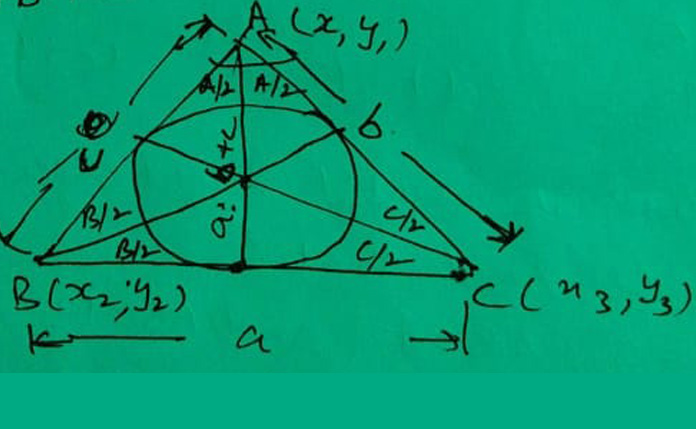
Note: In an equilateral triangle, incentre cobncide with the centriod,
Solution:
A(1, √3) B(0, 0) C(2, 0)
AB = 2 = BC = AC
The triangle is equilateral, its incentre concides with the centroid whose co-ordinates are:
( 1 + 0 + √2 3 , √3 + 0 + 0 3 )
= (1, 1/√3)
Solution:
∆ OAB is right angled at 0 such that
OA = 5, OB = 12 and AB = 13

So, the co-ordinates of incentre are
( 13x0 + 5x0 + 12x5 13 + 5 + 12 , 13x0 + 5x12 + 12x0 13 + 5 + 12 )
i.e. (2, 2)
Solution:
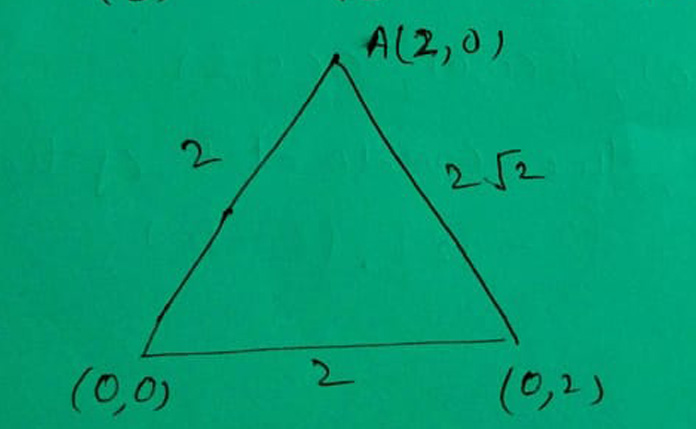
In the given problem the coordinates of mid points are D(0, 1), E(1, 1) and F(1, 0).
So the coordinates of vertices are A(2, 0), B(0, 0) and C(0, 2).
∴ Coordinates of the incentre are
( 2x2 + 2√2x0 + 2x0 2 + 2√2 + 2 , 2x0 + 2√2x0 + 2x2 2 + 2√2 + 2 )
Or
( 2 2√2 , 2 2√2 )
Or
(2 - √2, 2 - √2)
Solution:
Let D(0, 1), E(1, 1) and F(1, 0) be the mid points of sides BC, CA and AB respectively of ∆ABC. Then the coordinates of the vertices are
A(1 + 1 - 0, 0 + 1 - 1), B(0 + 1 - 1, 1 + 0 - 1), C(0 + 1 - 1, 1 + 1 - 0)
A(2, 0), B(0, 0) and C(0, 2)
Hence, the coordinates of the incentre
are (2 - √2), (2 - √2)
Solution:

Let ABC be the given triangle whose vertices are A(1, 1), B(x1, y1) and C(x2, y2).
Let D(-1, 2) and E(3, 2) be the midpoints of AB and AC then
(x1 + 1)/2 = -1, (y1 + 1)/2 = 2
=> x1 = -3
=> y1 = 3
(x2 + 1)/2 = 3 => x2 = 5
(y2 + 1)/2 = 2 => y2 = 3
∴ the coordinates of the vertices of ∆ABC are A(1, 1), B(-3, 3) and C(5, 3)
∴ centroid
( 1 - 3 + 5 3 , 1 + 3 + 3 3 )
= (1, 7/3)
Circum centre of right angled triangle is mid point of hypotnuse.
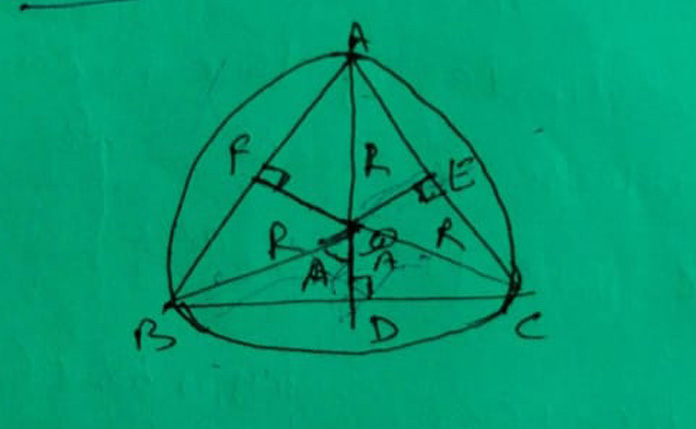
Distance of circum centre from sides
OD = R cosA, OE = R cosB and OF = R cosC
R - The radius of the circum circle of the triangle.
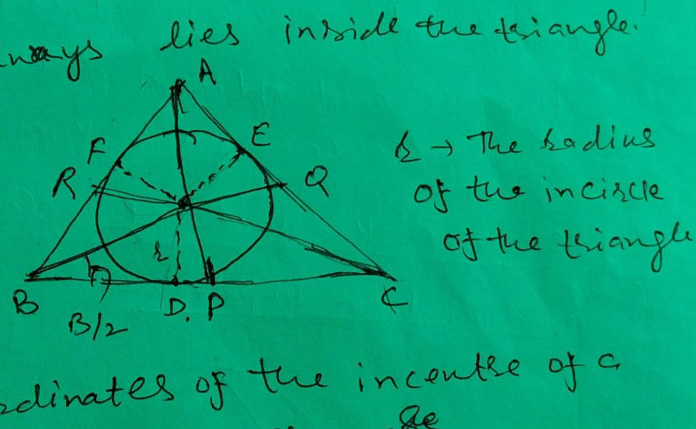
The co-ordinates of the incentre of a triangle whose vertices are (x1, y1), (x2, y2) and (x3, y3) are
I( ax1 + bx2 + cx3 a + b + c , ay1 + by2 + cy3 a + b + c )
Solution:
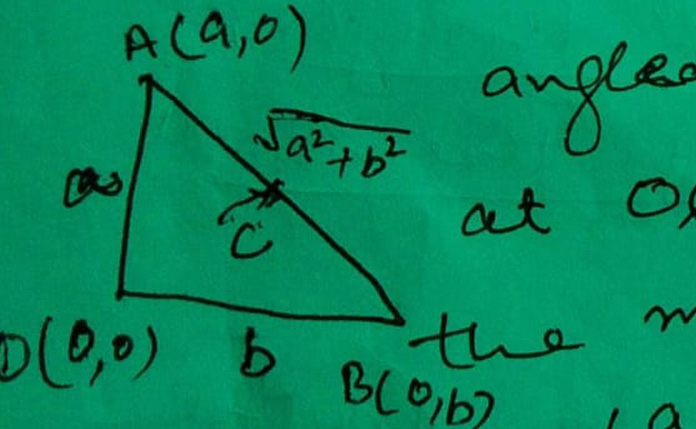
∆ OAB is right angled triangle right angled at O. So its orthocentre is at O(0, 0) and circumcentre is the mid point of its hypotnuse i.e. C(a/2, b/2)
∴ Required distance = √[(a/2 - 0)2 + (b/2 - 0)2]
= 1/2 √(a2 + b2)
=> In right angled triangle, right angled at O(0, 0) and orthocentre is (0, 0), circum centre is the mid points of its hypotnuse.
=> In an equilateral triangle, its incentre coincides with the centroid, coordinates of incentre and centroid are same.
=> In right angled triangle orthocentre lies on the vertex of a right angle.
=> Circumcentre(O), G(centroid) and H(x, y). Orthocentre are collinear such that G divides OH in the ratio 1:2
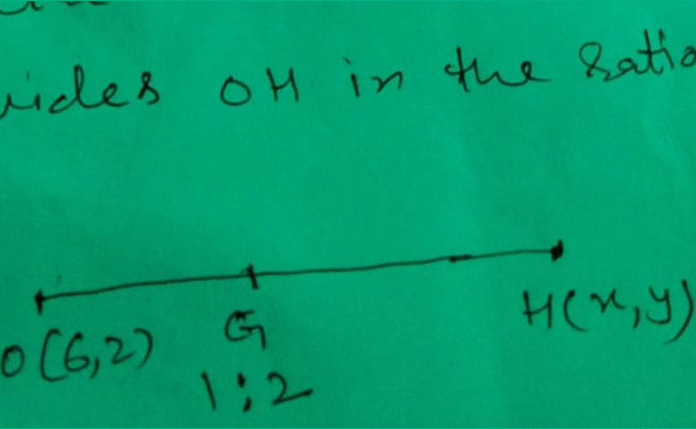
Circumcentre: Perpendicular bisectors of the sides are concurrent known as circumcentre.
Circumcentre of right angled triangle is the mid point of hypotenuse.
Solution:
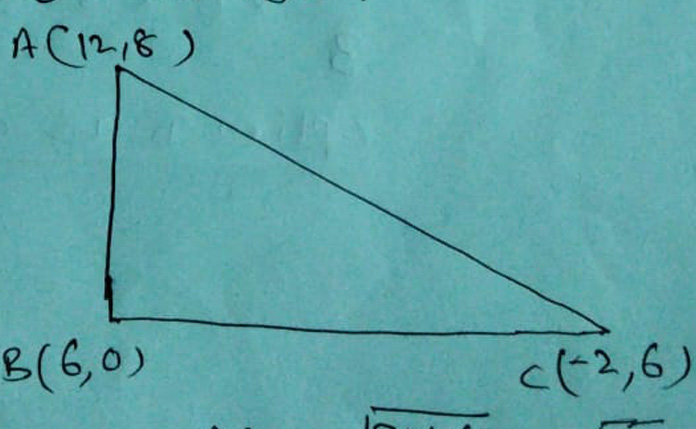
AB = √(36 + 64) = √100
BC = √(36 + 64) = √100
AC = √(4 + 196) = √200
AC2 = AB2 + BC2
(√200)2 = (√100)2 + (√100)2
200 = 100 + 100 = 200
∴ ∆ABC is a right angled ∆ at B.
In right angled ∆ orthocentre lies on the vertex of a right angle i.e. at B and circumcentre is the mid point of its hypotnuse i.e. [(-2 + 12)/2, (8 + 6)/2] or O(5, 7)
Centroid = G[(12 + 6 - 2)/3, (8 + 0 + 6)/3]
= G(16/3, 14/3)
∴ Product of abcissa of centroid, orthocentre and circumcentre is
= (16/3)x6x5
= 160
Option D is correct
Circumcentre O, centroid G and orthocentre H of an acute ∆ ABC are collinear. G divides OH in the ratio 1:2 i.e. OG:GH = 1:2
In an isosceles triangle, centroid, orthocentre, incentre and circumcentre lie on the same line. In an equilateral triangle, all these four points coincide.
Solution:
O(6, 2) -> circumcentre, G(3, 3) -> centroid and H(x, y) -> orthocentre are collinear such that G divides OH in the ratio 1:2
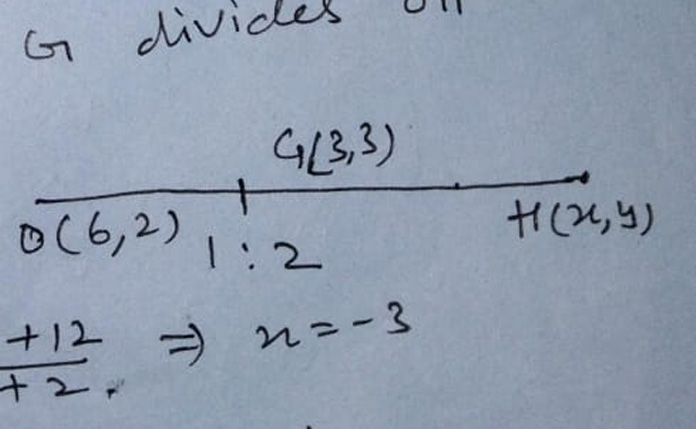
∴ 3 = (x + 12)/(1 + 2) => x = -3
and 3 = (y + 4)/(1 + 2) => y = 5
∴ The co-ordinates of orthocentre are (-3, 5)
Solution:
The circumcentre is at the origin and the centroid is at
{(a2 + 1 + 2a)/2, (a2 + 1 - 2a)/2}
i.e at {(a + 1)2/2, (a - 1)2/2}
Let (x, y) be the orthocentre, Since centroid divides the line segment joining circumcentre and orthocentre in the ratio 1:2
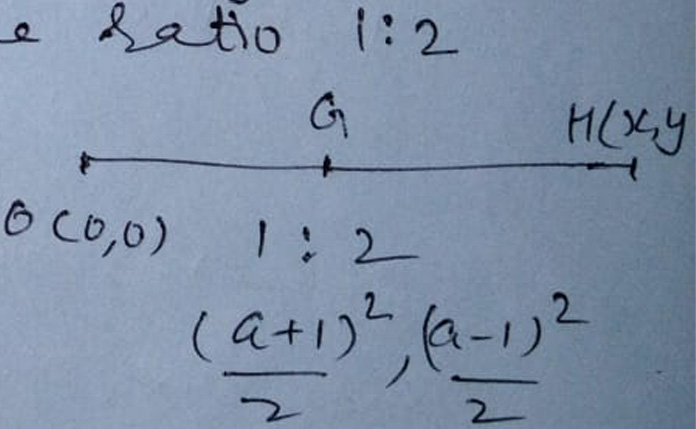
(a + 1)2/2 = x/3 -(1)
(a - 1)2/2 = y/3 -(2)
Dividing 1 and 2
(a + 1)2/(a - 1)2 = x/y
=> (a - 1)2x = (a + 1)2y
Solution:
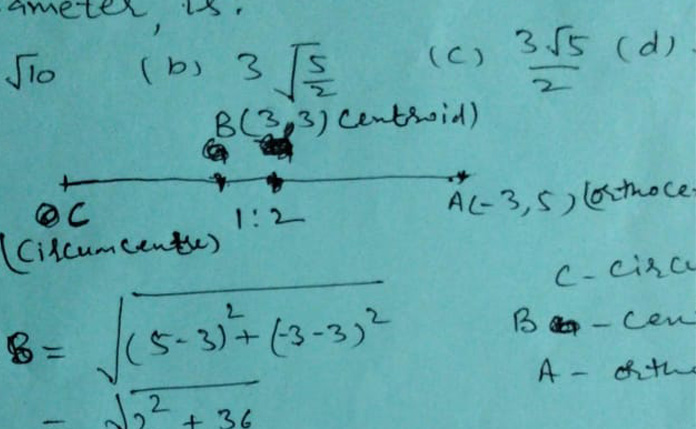
C - Circumcentre
B - Centroid
A - Orthocentre
∴ AB = √{(5 - 3)2 + (-3 - 3)2}
= √(22 + 36)
= √40
= 2√10
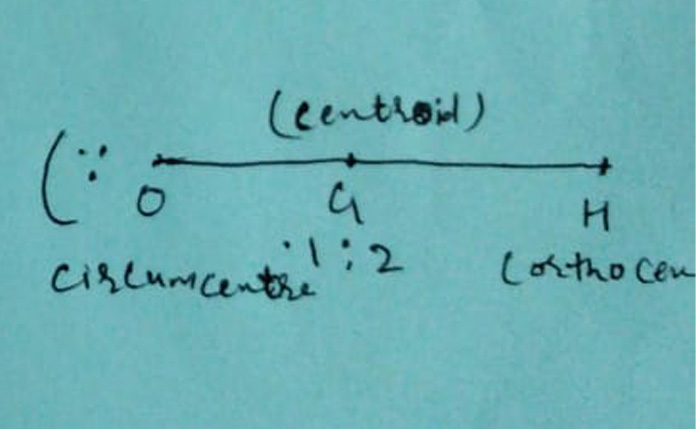
∴ AC = (3/2)AB
= (3/2) x 2√10
= 3√10
Hence radius = (3/2)√10
= 3{√(10/4)}
= 3{√(5/2)}
Key Concept
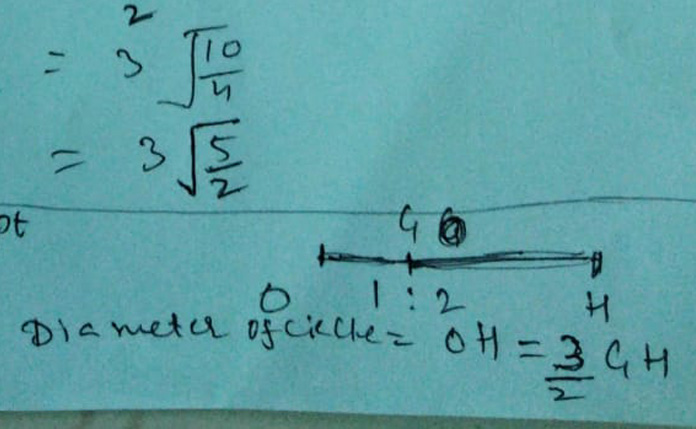
Solution:

O' - Circumcentre
G - Centroid
H - Orthocentre
O'(5/2, 5/2)
G(1/3, 2/3)
H(x, y)
Centroid G = {(0 + 2 - 1)/3, (0 - 1 + 3)/3} = G(1/3, 2/3)
Hence G divides O'H in the ratio 1:2
[{x + (5/2)x2}/3] = 1/3
=> x + 5 = 1 or x = -4
{y + 2x(5/2)}/3 = 2/3
=> y + 5 = 2 => y = -3
∴ H(-4, 3)
Solution:
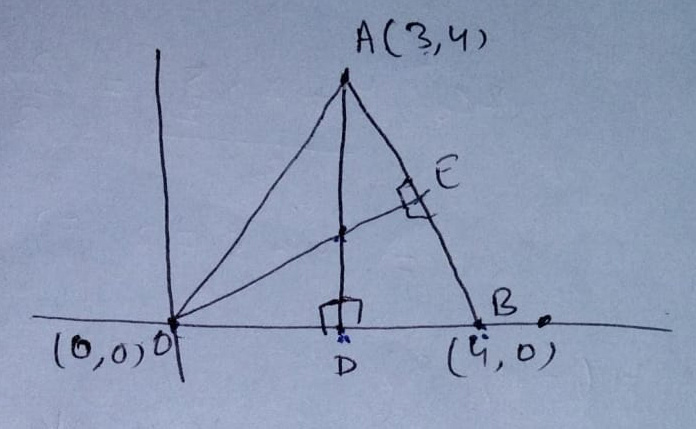
We know that orthocentre is the meeting point of altitudes of a ∆
Equation of altitude AD
AD is line ∥ to y-axis through(3, 4)
=> x = 3 -(1)
Equation of OE.
OE passes through (0, 0) and is perpendicular to AB
y = (1/4)x -(2)
∴ from (1) and (2)
We get orthocentre as (3, 3/4)
Solution:

Mid point of AB = (3/2, 0)
x = 3/2 is the equation of bisectors of AB
Mid point of AC = (0, 2)
Equation of bisectors of AC is y = 2
(3/2, 2) is the circumcentre of required ∆
Solution:

Let C(x, y) be the third vertex of ∆ABC.
Let AL and BM be two altitudes of ∆ABC. It is given that O(0, 0) is the orthocentre of ∆ABC
∴ OA ⊥ BC and OB ⊥ AC
=> BC is parallel to x-axis and slope OB x slope of AC = -1
=> y - 3 = 0 and [{3/4} x {(b - 2)/(a - 0)}] = -1
=> y = 3 and 4a + 3b = 6
b = 3, and a = -3/4
Clearly, C(a, b) = (-3/4, 3)
Key Point
Conjugate Harmonic Function:
If f(2) = 4 + iv is an analytics finction, then "v" is the conjugate harmonic of "u" and vice versa.
If f(z) = u + iv is an analytical function, then f(z) = -v + iu, u and v are harmonic conjugates.
Solution:
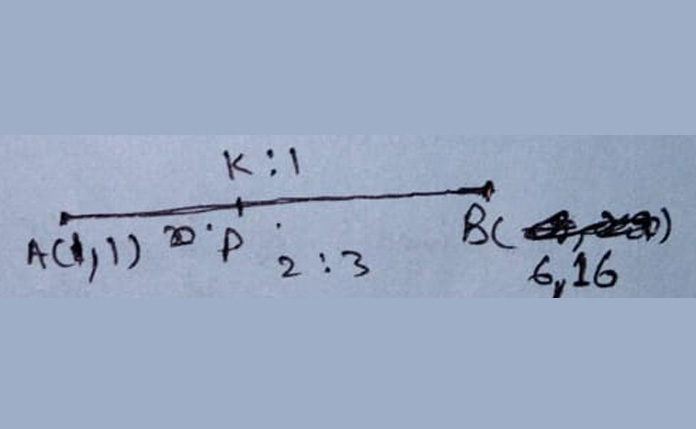
(6k + 1)/(k + 1) = 3 => 6k + 1 = 3k + 3 => k = 2/3
(16k + 1)/(k + 1) = 7
=> P divides AB internally in the ratio 2:3
Thus Q divides AB externally in the ratio 2:3 and hence its coordinates are
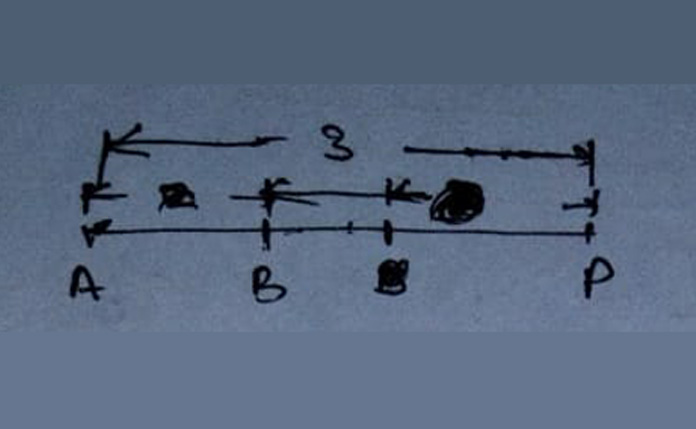
{(2x6 - 3x1)/(2 - 3), (2x16 - 3x1)/(2 - 3)}
= (-9, -29)
Solution:
Given points are P(-4, 2), A(2, -4) and B(7, 1)
Suppose P divides AB in ratio k:1, then
=> P divides AB internally in the ratio 2:3
Thus Q divides AB externally in the ratio 2:3 and hence its coordinates are
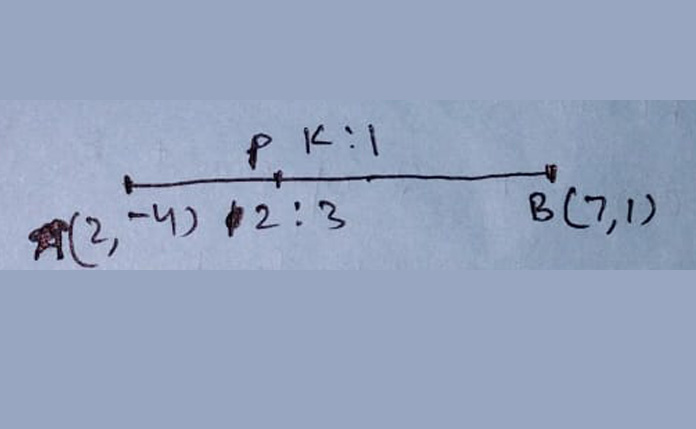
(7k + 2)/(k + 1) = 4 => k = 2/3
∴ P divides AB internally in the ratio 2:3
The coordinates of the point a dividing AB externally in the ratio 2:3 are
(2x7 - 3x2)/(2 - 3), (2x1 - 3x4)/(2 - 3)
=(-8, -14)
Hence the harmonic conjugate of R with respect to A and B is (-8, -14)
Key Point: Family of lines:
Let L1 = a1x + b1y + c1 = 0 and
L2 = a2x + b2y + c2 = 0
then the equation of the lines passing through the point of intersection of these lines is
L1 + λL2 = 0 where λ ∈ R
These lines from a family of straight lines from point P.
Also this general equation satisfies the point of intersection of L1 and L2 for any value of λ is obtained with the help of the addiotional information given in the problem.
Solution:
The equation of any line through the point of intersection of the given line is
2x + 3y + 5 + λ(5x - 2y - 16) = 0 - (1)
But the required line passes through (-1, 3)
∴ Weget
-2 + 9 + 5 + λ(-5 - 6 - 16) = 0
Hence, λ = 4/9 - (2)
∴ From 1 and 2
2x + 3y + 5 + 4/9(5x - 2y - 16) = 0
=> 9(2x + 3y + 5) + 4(5x - 2y - 16) = 0
Simplifying, we get
2x + y - 1 = 0
Solution:
Given equation is
x(a + 2b) + y(a + 3b) = a + b
=> a(x + y - 1) + b(2x + 3y - 1) = 0 -(1)
Both a and b cannot be simultaneously zero.
∴ at least one a and b will be non-zero, let a ≠ 0
(1) can be written as
x + y - 1 + b/a(2x + 3y - 1) = 0
x + y + 1 + λ(2x + 3y - 1) = 0
where λ = b/a
From (2) it is clear that (2) passes through the point of intersection of lines x + y - 1 = 0, and 2x + 3y - 1 = 0 solving, weget x = 2, y = - 1
Hence the lines
Key Point:
If two vertices of an equilateral triangle have the co-ordinates (x1, y1) and (x2, y2), then the co-ordinates of its third vertex are:
[{x1 + x2 ± √3(y1 - y2)}/2, {y1 + y2 ± √3(x1 - x2)}/2]
Solution:
{2 + 2 ± √3(-2)}/2, {10 ± √3(0)}/2
{4 ± √3(-2)}/2, 5
(2 ± √3, 5)
Call to Our Experts: +91-888-364-6566
Whether you're preparing for exams, struggling with specific topics, or seeking advanced math instruction, we're here to provide the guidance and support you need. Contact us now and let's make math not just understandable but enjoyable.